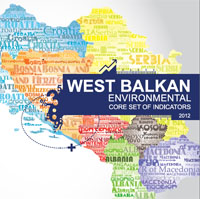| CONSUMPTION OF OZONE DEPELTING SUBSTANCES | |
Substances that deplete the ozone layer (ODSs) are the compounds which cause depletion of the ozone layer. This group includes CFCs, HCFCs, HВFCs CCl4, halons, methyl chloroform, methyl bromide. In general, these compounds are very stable in troposphere and they decompose only under the influence of ultra-violet radiation emitted by the Sun. While decomposing, they release chlorine or bromine atoms which destroy the molecules of stratospheric ozone.
This indicator quantifies the consumption of ozone-depleting substances (ODSs) in the Republic of Macedonia.
§ODSs consumption is expressed in ODP tons which means quantity of each substance in metric tonnes (MT) multiplied by its Ozone Depletion Potential (ODP).
Does Macedonia fulfil the targets specified under the Montreal Protocol concerning ODSs reduction and elimination?
Considering the extent of ODSs elimination in the Republic of Macedonia, it may be concluded that the percentage of more than 99.87% of ODSs phased-out in the observed period reflects the fact that our country has not only fulfilled its obligations under the Montreal Protocol, but reached beyond the requirements specified in the Protocol.
Figure 1: Consumption of Ozone Depleting Substances (ODP t/year)
 Note: Given the fact that the Republic of Macedonia has never produced any ODS, the diagram includes data only on ODSs consumption
Note: Given the fact that the Republic of Macedonia has never produced any ODS, the diagram includes data only on ODSs consumption
Data coverage: excel
Source: (www.ozoneunit.gov.mk) MEPP/Ozone Unit
According to data contained in the Country Programme for Phasing-out Substances that Deplete the Ozone Layer(1996), the average consumption of ODSs in the observed period amounted 527 tons. According to the provisions of the Montreal Protocol, the said average has been taken as a base level in determining the extent of reduction to be achieved within the restrictions provided for by the Protocol. Table 1 shows the trend of decline in ODSs consumption in the period of the last ten years (2004 – 2013). Apart from ODSs elimination in industry (production of refrigerators and production of rigid and flexible foams), where technologies using ozone depleting substances before 1997 were replaced by non-ODSs solutions, interventions were also made in agriculture through substitution of methyl bromide with alternative solutions that did not involve application of ODSs, in cooling devices servicing and maintenance through establishment of the system for ODS collection and recycling. In the context of the latter, equipment for collection and recycling of cooling devices have been delivered to services and service technicians were trained in good cooling devices servicing practice. For the same purpose, training was organized for custom officers to control import-export of ozone depleting substances at border-crossings of the Republic of Macedonia.
The national action for ozone layer protection during the observed period has resulted in the complete elimination of the consumption of ODSs in the Republic of Macedonia.
- Methodology for the indicator calculation
The Indicator shows the quantity of consumed ODSs. The value presented has been obtained by multiplying the value of the consumed quantity expressed in metric tons by the Ozone Depletion Potential (ODP). The Table below presents the values of ODP for substances identified to be applied in the Republic of Macedonia and the consumption of which is subject of reduction or control. The Ministry of Environment and Physical Planning/Ozone Unit has data on ODSs consumption in both metric and ODP tons.
| ODSs | CFC-11 | CFC-12 | CFC-113 | CFC-114 | CFC-115 | CFC-111 | CCl4 | Halon 1211 | Halon 1301 | HCFC-22 | HCFC-141b | Methyl bromide |
| Value of ODP | 1 | 1 | 0.8 | 1 | 0.6 | 1 | 1.1 | 3 | 10 | 0.055 | 0.11 | 0.7 |
List of relevant policy documents
National Environmental Action Plan (NEAP II, 2006)
Country Programme for Phasing-out Substances that Deplete the Ozone Layer (1996) – strategic document establishing the main directions in the domain of management and elimination of ODSs in the Republic of Macedonia. It was adopted in 1996. Based on the recommendations of the Country Programme, ODSs elimination has been completed in industry (production of refrigerators, flexible and rigid foams), agriculture, private sector. By 2011, more than 99% of ODSs consumption defined in the National Programme was eliminated. Projects have been implemented by means of the financial support provided by the Multilateral Fund of the Montreal Protocol through the Ministry of Environment and Physical Planning/Ozone Unit.
Legal grounds
- Law on the Ratification of the Vienna Convention for the Protection of the Ozone Layer was adopted by the Republic of Macedonia by means of succession in 1994.
- Law on the Ratification of the Montreal Protocol onSubstances that Deplete the Ozone Layerwasadopted by the Republic of Macedonia by means of succession in 1994.
- Law on the Ratification of London Amendment to the Montreal Protocol.
- Law on the Ratification of Copenhagen Amendment to the Montreal Protocol.
- Law on the Ratification of Montreal Amendment to the Montreal Protocol.
- Law on the Ratification of Beijing Amendment to the Montreal Protocol.
- Law on Environment.
- Order banning the import of air-conditioning devices that contain HCFCs.
- Order restricting the import of ozone depleting substances.
- Order banning production of and trade in ozone depleting substances, as well as production of and trade in products containing ozone depleting substances.
- Order banning import and export of HCFC containing products.
- Rulebook on ozone depleting substances, as well as products containing ozone depleting substances.
- Rulebook on the manner of collection, recovery and recycling of ozone depleting substances.
- Order banning the trade in cooling products in disposable cylinders.
- Rulebook on the format and the content of the programme for training in proper handling, servicing, collection, recovery and recycling of cooling devices and/or cooling devices containing products, detailed requirements to be fulfilled by legal persons perfoming training in proper handling, servicing, collection, recovery and recycling of cooling devices and/or cooling devices containing products, as well as the manner of authorization for performance of training proper handling, servicing, collection, recovery and recycling of cooling devices and/or cooling devices containing products
- Rulebook on the format, content and manner of reporting on the types and quantities of collected, recovered and recycled cooling devices
- Rulebook on the format and content of the certificate for complteted training cooling devices and/or cooling devices containing productshandling.
By the act of ratification of the Montreal Protocol, the Republic of Macedonia has undertaken all obligations deriving from this document. According to the obligations specified in the Protocol, the schedule for the ODSs elimination is as follows:
| Montreal Protocol | Controlled substances applied in the Republic of Macedonia | Obligations of the Republic of Macedonia (as Article 5 country under the Montreal Protocol) | |
| Annex | Group | ||
| A | I | CFC-11
CFC-12 CFC-115 |
Base level: Mean of the consumption in 1995-1997
Freeze : 1 July 1999 50% reduction : 1 January 2005 85% reduction : 1 January 2007 100% reduction : 1 January 2010 |
| II | Halon-1211
Halon -1301 Halon -2402 |
Base level: Mean of the consumption in 1995-1997
Freeze : 1 January 2002 50% reduction : 1 January 2005 |
|
| С | I | HCFC-22
HCFC-141b |
Base level: Consumption in 2009-2010
Freeze : 1 January 2013 10% reduction : 1 January 2015 35% reduction : 1 January 2020 67,5% reduction : 1 January 2025 97,5% reduction : 1 January 2030 100% reduction : 1 January 2040 |
| Е | I | Methyl bromide | Base level: Mean of the consumption in 1995-1998
Freeze : 1 January 2005 100% reduction : 1 January 2015 |
- UNEP- Secretariat for Ozone Layer Protection
- Multilateral Fund of the Montreal Protocol
| Code | Title of the indicator | Compliance withCSI ЕЕА or other indicators | Classification by DPSIR | Type | Linkage with area | Frequency of publication | |
| MKNI 006 | Consumption of ozone depleting substances | CSI 006 | Consumption of ozone depleting substances | P | B |
|
annually |





































































